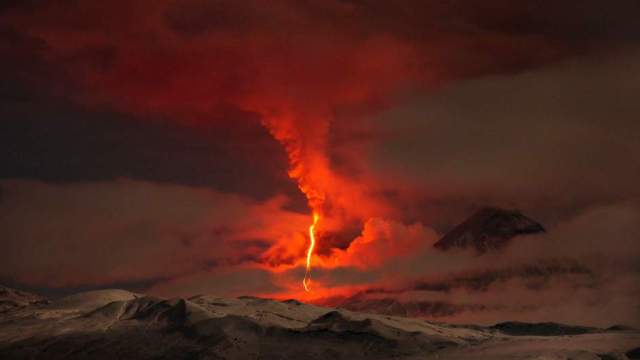Volcanoes
Volcano information gathered from various sources, including the Smithsonian Weekly Volcanic Activity Report from which confirmation of reports is taken. A volcano is only included in the listing if there is significant ash above 1km height (white/steam clouds are not counted) or there is a significant lava flow. Crater incandescence, unless accompanied by the either of the preceding does qualify as an eruption.
Volcano Chart

(Click the Image for a larger/clearer version)
Volcanoes erupting this week contributing to the chart.(6)
Cleveland Chuginadak Island
Dukono (Halmahera Indonesia)
Pavlof (United States)
Sangeang Api (Indonesia)

Shiveluch (Kamchatka. Russia)
Ubinas (Peru)
ALASKA VOLCANO OBSERVATORY WEEKLY UPDATE
Friday, June 6, 2014 1:27 PM AKDT (Friday, June 6, 2014 21:27 UTC)
PAVLOF VOLCANO (VNUM #312030)
55°25’2″ N 161°53’37” W, Summit Elevation 8261 ft (2518 m)
Current Volcano Alert Level: WATCH
Current Aviation Color Code: ORANGE
The eruption of Pavlof Volcano that began late on the evening of May 30 is continuing, although the level of activity has declined appreciably over the past 24 hours. Elevated surface temperatures at the summit of the volcano persist in satellite images indicative of continued effusion of lava, cooling lava flows and spatter, or both. At present, ash emissions appear to be greatly reduced and no ash or steam plumes have been evident in satellite images since June 4, although cloud cover has obscured the volcano since Wednesday, June 4. Significant emissions of SO2 gas have been observed in satellite images beginning several days into the eruption.
Beginning May 31, the level of activity escalated gradually and the volcano was producing a nearly continuous ash plume from June 2-4, and ash and steam plumes up to 30,000 feet were observed in clear satellite and web camera images. AVO raised the Aviation Color Code and Volcano Alert Level to RED/Warning on the afternoon of Monday, June 2 as a result of rapidly increasing seismicity and observations of ash plumes above 20,000 feet. This level of eruptive activity persisted for about 6 hours before beginning to decline back to earlier levels, and soon after AVO reduced the status to ORANGE/Watch on Tuesday, June 3, 2014, at 5:54 PM AKDT (01:54 UTC June 4) where it presently remains. Observations this morning indicate a pause in eruptive activity and greatly diminished ash emissions and lava production at the vent.
The largest ash and steam plumes generated thus far have reached about 30,000 ft ASL and have extended about 50-60 mi (80-90 km) downwind of the volcano. AVO has received no reports of significant ash fallout on communities near the volcano, including Sand Point, King Cove, Nelson Lagoon, or Cold Bay, although trace amounts of ash may have reached these areas on occasion. Significant ash fallout has been limited to the immediate area surrounding the volcano. Seismic data from stations on the north flank of the volcano indicate that volcanic mudflows (lahars) have been occurring intermittently and these are likely causing minor flooding in the main drainages on the north flank of the volcano. The extent of inundation associated with these flows is not yet known.
Pavlof Volcano is experiencing a typical Strombolian eruption, characterized by lava fountaining, minor explosions, and the accumulation of spatter on the upper north flank of the volcano. Accumulations of spatter have occasionally built up and collapsed, forming hot, ashy, particle-rich flows that generate high-rising steam plumes on the lower north flank of the volcano. As these flows interact with ice and snow on the volcano, they produce meltwater and steam plumes. Spatter-fed lava flows also are likely forming.
http://www.avo.alaska.edu/activity/
Volcanoes active this week contributing to the chart. (38)
Anak Krakatau (Indonesia)
Bagana (Papua New Guinea)
Batu Tara (Sunda Islands Indonesia)
Chaparrastique [San Miguel] (El Salvador)
Chirinkotan (Russia)
Chirpoi [Snow](Russia)
Colima (México)
Copahue (Chile)
Etna (Sicily Italy)
Fuego (Guatemala)
Heard (Australia)
Ibu (Halmahere – Indonesia)
Karangetang [Api Siau] (Indonesia)
Kelut (E. Java. Indonesia)
Kirishimayama (Shinmoedake) (Japan)
Kusatsu-Shiranesan (Japan)
Lewotobi Perempuan (Indonesia)
Lokon-Empung (Indonesia)
Mount Bromo ( Indonesia.)
Mount Oyama (Miyake-jima – Izu Islands)
Nishino-shima (Japan)
Nyamuragira Democratic Republic Of Congo
Pacaya (Guatemala)
Paluweh [Rokatenda] (Lesser Sunda Islands)
Poas (Costa Rica)
Popocatépetl (México)
Raung (East Java Indonesia)
Reventador (Ecuador)
Semeru (E Java. Indonesia)
Shishaldin (Fox Islands. USA)
Sinabung (Indonesia)
Slamet volcano (West Java)
Soputan (Indonesia)
Suwanose-jima (Ryuku Islands)
Tungurahua (Ecuador)
Ulawun (New Britain Papua New Guinea)
Unnamed (Gadiyada village – India)
Veniaminof (United States)
KVERT web page: Kamchatka and the Northern Kuriles volcanoes: Erupting or Restless
Volcanic Ash Advisory Centre advisories
Anchorage VAAC
Australian VAAC
Buenos Aires VAAC
London VAAC
Montréal VAAC
Tokyo VAAC
Toulouse VAAC
Washington VAAC
Wellington VAAC
Aviation Colour Codes
This forms a part of the QVSData geophysical report for the week ending 6th June 2014










